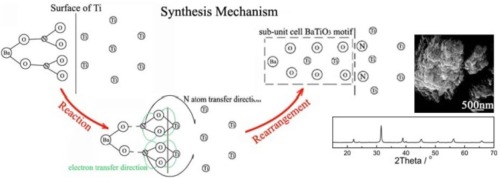当前位置:
X-MOL 学术
›
Mater. Chem. Phys.
›
论文详情
Our official English website, www.x-mol.net, welcomes your
feedback! (Note: you will need to create a separate account there.)
Solid-state synthesis semiconducting BaTiO3 nanoparticles at low temperature
Materials Chemistry and Physics ( IF 4.3 ) Pub Date : 2020-02-01 , DOI: 10.1016/j.matchemphys.2019.122496 Jianquan Qi , Yan Li , Xinyi Zhang , Jiang Wang , Qinqin Zhang , Yingfang Xue , Jing Cheng , Mengying Li , Xiumei Han , Zhenwei Ma , Daran Fang
Materials Chemistry and Physics ( IF 4.3 ) Pub Date : 2020-02-01 , DOI: 10.1016/j.matchemphys.2019.122496 Jianquan Qi , Yan Li , Xinyi Zhang , Jiang Wang , Qinqin Zhang , Yingfang Xue , Jing Cheng , Mengying Li , Xiumei Han , Zhenwei Ma , Daran Fang

|
Abstract We report a simple and facile approach for the synthesis of semiconducting BaTiO3 nanoparticles at low temperature using a direct solid state reaction between metal Ti and barium nitrate. The irregular large grain-sized Ba(NO3)2 and Ti powders can be converted into homogenous BaTiO3 nanoparticles. The morphologies and structures of the BaTiO3 nanoparticles can be facilely tuned. The semiconducting BaTiO3 nanoparticles can be obtained at the condition of Ba/Ti ratio between 1:1 and1:3 just calcinated at 550 °C. The residual Ba(NO3)2 can be clear observed when Ba/Ti > 1:1, and titanium nitride appear when Ba/Ti~1:16.The reaction of synthesis of semiconducting BaTiO3 nanoparticles starts at 550 °C. Under the suitable conditions, semiconducting BaTiO3 nanoparticles can be prepared with the grain size~30 nm homogenously. During synthesis reaction, the transfer of N cation into Ti lattice is proposed for the mechanism of direct reaction between Ba(NO3)2 and Ti for synthesis of BaTiO3 nanoparticles, which results in cation N decreases its valence and turns to an anion.
中文翻译:

低温固态合成半导体BaTiO3纳米颗粒
摘要 我们报告了一种使用金属钛和硝酸钡之间的直接固态反应在低温下合成半导体 BaTiO3 纳米粒子的简单易行的方法。不规则的大颗粒 Ba(NO3)2 和 Ti 粉末可以转化为均匀的 BaTiO3 纳米颗粒。BaTiO3 纳米粒子的形态和结构可以很容易地调整。在Ba/Ti比在1:1和1:3之间的条件下,只需在550℃下煅烧即可获得半导体BaTiO3纳米颗粒。当Ba/Ti>1:1时可以观察到残留的Ba(NO3)2,当Ba/Ti~1:16时出现氮化钛。半导体BaTiO3纳米粒子的合成反应在550℃开始。在合适的条件下,可以均匀地制备出粒径~30 nm的半导体BaTiO3纳米颗粒。
更新日期:2020-02-01
中文翻译:

低温固态合成半导体BaTiO3纳米颗粒
摘要 我们报告了一种使用金属钛和硝酸钡之间的直接固态反应在低温下合成半导体 BaTiO3 纳米粒子的简单易行的方法。不规则的大颗粒 Ba(NO3)2 和 Ti 粉末可以转化为均匀的 BaTiO3 纳米颗粒。BaTiO3 纳米粒子的形态和结构可以很容易地调整。在Ba/Ti比在1:1和1:3之间的条件下,只需在550℃下煅烧即可获得半导体BaTiO3纳米颗粒。当Ba/Ti>1:1时可以观察到残留的Ba(NO3)2,当Ba/Ti~1:16时出现氮化钛。半导体BaTiO3纳米粒子的合成反应在550℃开始。在合适的条件下,可以均匀地制备出粒径~30 nm的半导体BaTiO3纳米颗粒。


















































 京公网安备 11010802027423号
京公网安备 11010802027423号